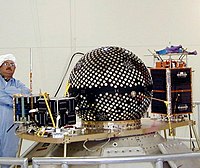SAPPHIRE
Appearance
 SAPPHIRE satellite | |
| Mission type | Communications |
|---|---|
| Operator | USNA/University of Santa Clara |
| COSPAR ID | 2001-043D[1] |
| SATCATno. | 26932 |
| Mission duration | 2 years and 6 months |
| Spacecraft properties | |
| Manufacturer | Stanford University |
| Launch mass | 16 kg (35 lb) |
| Start of mission | |
| Launch date | 30 September 2001, 02:40 UTC |
| Rocket | Athena 1LM-001 |
| Launch site | Kodiak LP-1 |
| Contractor | Lockheed Martin |
| End of mission | |
| Disposal | Decommissioned |
| Last contact | 2005 |
| Orbital parameters | |
| Reference system | Geocentric |
| Regime | Low Earth |
| Eccentricity | 0.0[1] |
| Altitude | 794 km (493 mi)[1] |
| Inclination | 67°[1] |
| Period | 101 minutes[1] |
| Epoch | 30 Sep 2001[1] |
SAPPHIRE(Stanford AudioPhonic PHotographic IR Experiment,also calledNavy-OSCAR 45) was a satellite built by theStanford Universitystudents inPalo Alto, California.[1]

The satellite was launched on September 30, 2001 together withStarshine 3,PICOSatandPCSaton anAthena 1 rocketat theKodiak Launch Complex,Alaska,United States.
Its purpose was the training of students, the operation of aninfrared sensor,adigital camera,a speech synthesizer and from 2002 the operation of an APRSdigipeater.[2]He also served to train midshipmen of theUS Naval Academyin the field of satellite control.
The satellite's mission ended in early 2005.
Frequencies
[edit]- Uplink:145.945 MHz
- Downlink:437.1 MHz
- Mode:1200 bit/s AFSK
- Call sign:KE6QMD[3]
See also
[edit]External links
[edit]References
[edit]- ^abcdefgNASA Goddard Space Flight Center."SAPPHIRE".RetrievedFebruary 15,2020.
- ^"SAPPHIRE (Stanford AudioPhonic Photographic IR Experiment)".eoportal.org.Retrieved15 Feb2020.
- ^n2yo.com."SAPPHIRE".Retrieved15 Feb2020.
{{cite web}}:CS1 maint: numeric names: authors list (link)

